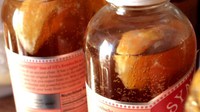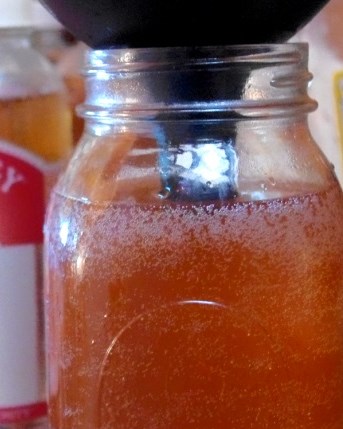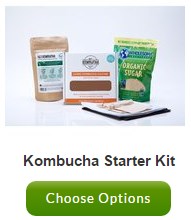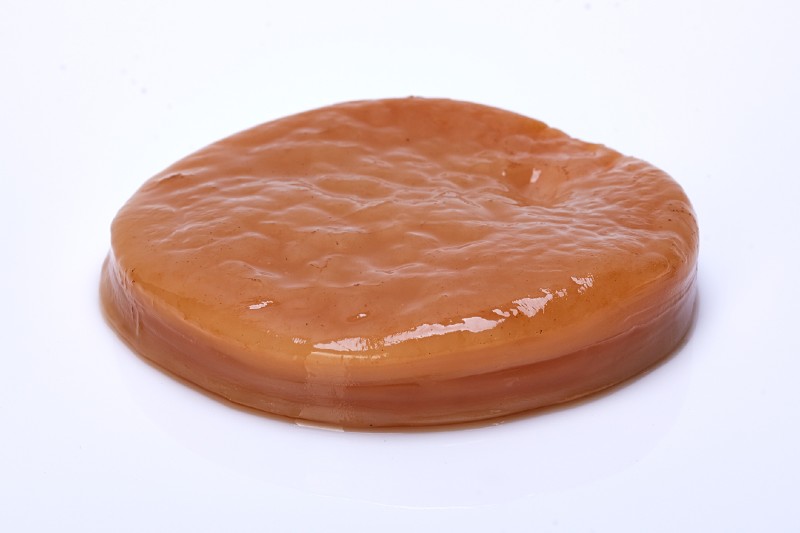- Home
- kombucha
Blog Categories
Recent Posts
Getting Started with Fermented Foods: Kombucha
Posted by on

The first time I tasted kombucha it came from a bottle that I purchased for over $3 at the whole foods market. I had just read about it in Nourishing Traditions and in my zeal to make some major dietary changes, I splurged. When I opened up I noticed bubbles, similar to what you would find in soda pop. I figured the taste would be similar to the other carbonated beverages I’d tasted so I went ahead and took a big gulp.
I nearly spit it out, fearing I would choke with the unexpected strength of this acidic, bubbly drink. It didn’t take more than a few additional sips to really appreciate the flavor and increased energy that I have always enjoyed in kombucha.
Since then I have purchased a bottle here and there as a treat, but at $3.50/bottle there was no way I could drink a glass per day. Eventually I took the plunge and started researching how to make my own. It turns out that once you get a SCOBY (symbiotic culture of bacteria and yeast – a mother or starter) the process is quite simple and hands off.
If you are wondering what kombucha is, then let’s back up for a moment. It is a fermented sweetened tea. The mother culture (SCOBY) consumes the sugar in the beverage and in the process gives the tea beneficial organisms, B vitamins, enzymes, and organic acids. It is tangy and lightly sweet and can be carbonated, if given a second fermentation under pressure.

Health Benefits
There are many health claims regarding kombucha. Like other fermented foods, it contains living bacteria, which are said to aid in digestion and help ward off candida. It is also said to aid in cleansing the liver 1. On a personal note, I have noticed an improvement in digestion and energy since I have started drinking it on a regular basis.
How to Make It
Kombucha is fairly easy to make. Here is the general method:
- First off do not use any metal jars or utensils for the process. I use large glass jars and a wooden spoon for stirring in the sugar.
- You can either obtain a scoby along with a small amount of kombucha from a premade batch or grow your own 2 from a bottle of raw organic kombucha.
- Brew up some sweetened black tea. (As a quick aside, I have read that organic teas will not contain the fluoride that some non-organic teas do.) You will use 2 tea bags and 1/4 cup sugar per quart. It is recommended that you use white sugar for the tea. It is said that the bacteria eat up the sugars in the tea if you allow it to ferment long enough, so the level of sugar in the final tea are dependent on how long you allow it to ferment.
- Allow tea to cool to room temperature and add your SCOBY (“mother”) and premade kombucha to the sweetened, brewed tea.
- Cover loosely with cheesecloth, a tea towel or a light cloth napkin and bind with a rubber band.
 Allow to ferment in a dark, warm
place for at least 5-7 days. After the first 5 days you can
taste it, but keep in mind that the longer you let it sit the
less sugar it will contain. For example, if you are trying to
avoid sugar, allowing the kombucha to ferment for a full two
weeks is reasonable. Keep in mind that the temperature at
which the tea ferments determines how quickly the fermentation
takes place. A warmer temperature will quicken the
fermentation process and vice versa.
Allow to ferment in a dark, warm
place for at least 5-7 days. After the first 5 days you can
taste it, but keep in mind that the longer you let it sit the
less sugar it will contain. For example, if you are trying to
avoid sugar, allowing the kombucha to ferment for a full two
weeks is reasonable. Keep in mind that the temperature at
which the tea ferments determines how quickly the fermentation
takes place. A warmer temperature will quicken the
fermentation process and vice versa.
- Once the tea has reached your desired level of fermentation, remove the original scoby and the newly formed “baby” scoby. You can now use these scobys to make more than one batch of fresh kombucha.
- Place an air-tight lid on your jar or transfer to smaller jars and cap. At this point you can refrigerate and allow to become more carbonated over time or do a second fermentation in an airtight container. Add a splash of juice, a piece of fruit, or herbs and other flavorings to customize your kombucha.
Where To Find Starters
If you are a bit apprehensive or unfamiliar with the culturing process, you may want to consider purchasing a scoby that will come with detailed instructions. You can purchase the kombucha SCOBY here. Or, for added convenience, you can purchase a full kombucha starter kit here.
Happy brewing!
References:
1. http://www.seedsofhealth.co.uk/fermenting/kombucha.shtml
2. http://www.foodrenegade.com/how-to-grow-a-kombucha-scoby/
Information provided in this communication is not designed to and does not provide medical advice, professional diagnosis, opinion, treatment or services to you or to any other individual. This is general information for educational purposes only. The information provided is not a substitute for medical or professional care, and you should not use the information in place of a visit, call consultation or the advice of your physician or other healthcare provider. Wise Choice Marketing Inc is not liable or responsible for any advice, course of treatment, diagnosis or any other information, services or product you obtain through Wise Choice Marketing Inc.

5 Top Health Coaches Spill Their Thoughts on Fermented Foods
Fermented foods. We spend lots of blog space talking about cultured vegetables and fermented foods of all kinds, from kombucha to sauerkraut, and with good reason. They’re chock full of health benefits, taste great, and have a long shelf life, too. There’s more to the story than what we think at Wise Choice Market, however. Health coaches and nutrition [...]

Coconut water kefir or kombucha: which is better for you?
Not everyone has a big kitchen and a pantry that’s spacious enough to make room for cultured foods of all kinds to grow happily. You also shouldn’t mix too many cultures in one space – they can contaminate each other, and depending on what you are growing, one culture may kill off the other. If mass microbial warfare isn’t [...]



 Loading... Please wait...
Loading... Please wait...












